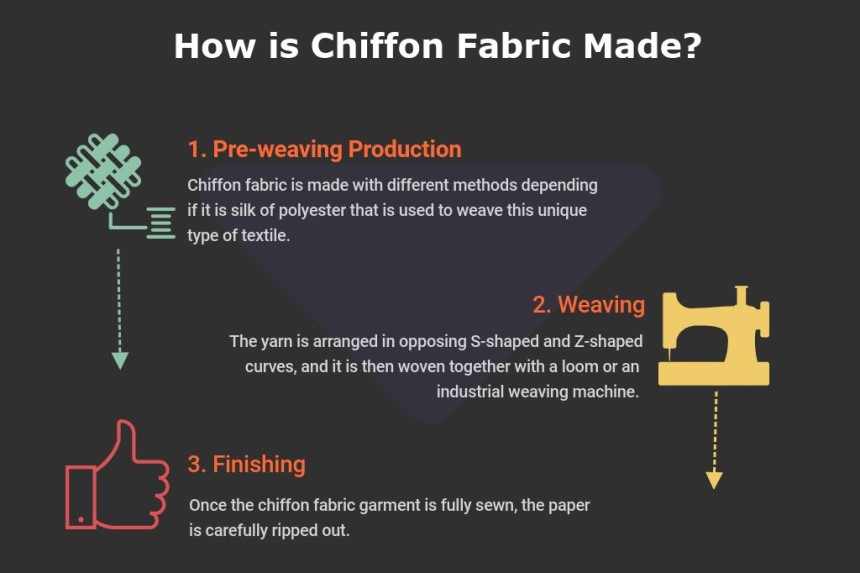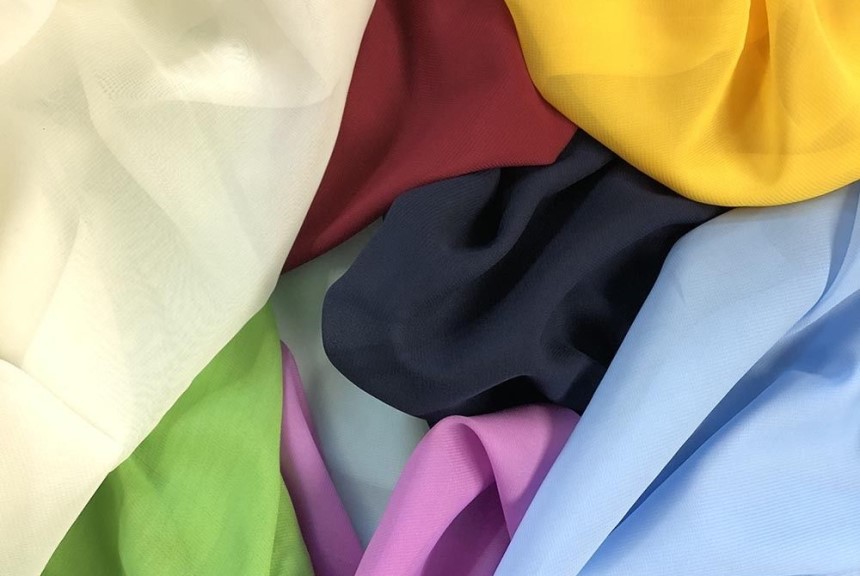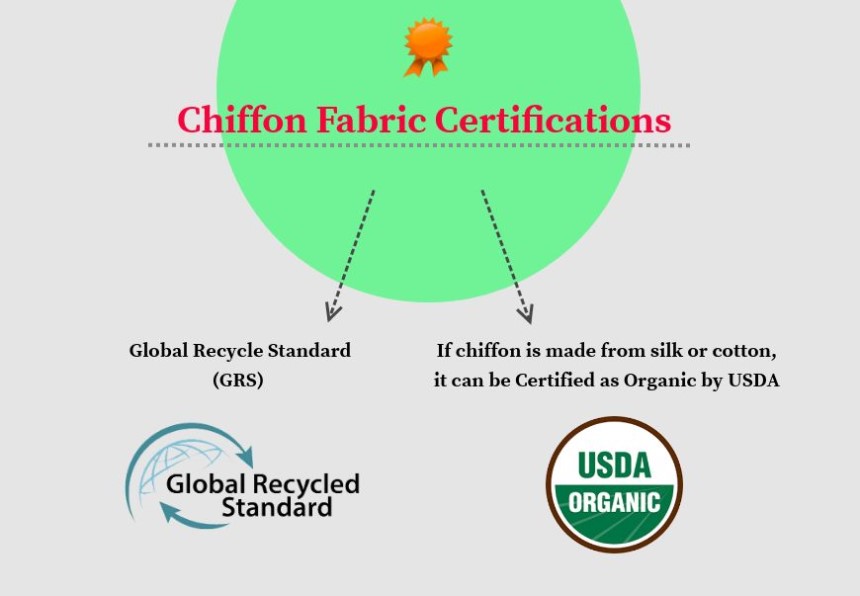

Chiffon is a fabric that is lightweight and balanced during the weaving of S – and Z twist crepe yarns. The twisting of the crepe yarns happens in both directions during the weaving, giving it some stretch and a rough feel. It is a perfect material for making dresses for formal and informal occasions. In essence, what is chiffon made of? Chiffon is a fabric type initially made of silk and then twisted in alternate directions to get a crumpled effect. Chiffon will do for chilly months, but you will need to select a long sleeve chiffon dress, while during summer, the shorter style will do better. Chiffon is also a fabric that is available for wedding dresses. It makes excellent bridesmaid dresses. Even though there are only three types of chiffon material, there are unlimited amounts of varying kinds of chiffon dresses. They vary depending on skirt lengths, fabric, skirt styles, waistlines, dress styles, and necklines. It is also popular among designers since they can twist it and come up with new trendy looks and styles.
Chiffon is a wide range of fabrics with similar qualities. It is lightweight and transparent. It has been in use over the years, even though it used to be expensive at the start since it was associated with a class. It has a wide application and usage among women in the USA. Chiffon products were first made in France, but the usage has spread in the entire world. In 1900, production of silk was low and wide production took place in the United States.
Chiffon has a wide application in the weaving process due to its lightweight that has a slight shine. You get chiffon from tiny puckers made into s and z crepe yarns twisted in anti-clockwise directions. The yarns are woven to make a plain weave. The crepe yarns usually are tighter than the standard crepe due to their twisting criteria. The chiffon fabric can be woven from various textile types, including synthetic, natural, Trusted Source Chiffon (fabric) - Wikipedia Chiffon is a lightweight, balanced plain-woven sheer fabric, or gauze, like gossamer, woven of alternate S- and Z-twist crepe (high-twist) yarns. The twist in the crepe yarns puckers the fabric slightly in both directions after weaving, giving it some stretch and a slightly rough feel. en.wikipedia.org silk, rayon, and polyester.
Chiffon is popularly used for making evening wear since it gives an elegant yet floating appearance to the gown. It is also popularly used for blouses, ribbons, and scarves. Chiffon is delicate to work with due to its light and slippery nature, and thus it needs one to handle it delicately.
Chiffon fabric can be made using many methods that vary depending on the sort of material used for weaving the unique kind of textile. For example, a product for silk will involve breeding silkworms and softening cocoons, and reeling elements. Producing polyester involves no organic components; thus, the fabric is made entirely on organic substances manufactured in the laboratory. Irrespective of the material used to make the chiffon fabric, the chiffon’s weaving takes a uniform formula once the textile yarn is complete. The yarn is used for making various types of textiles. The yarn used to make this type of textile is arranged in s-shaped and z-shaped curves and then woven together with a loom or an industrial weaving machine.
 How is it used?
How is it used?Chiffon has a wide application in making evening wear with beautiful drapes. It also has a variety of uses in the making of wedding dresses and fashionable wear. Chiffon is used to add to other fabrics since it doesn’t add weight but volume and appearance.
It is also used for making decorative fabrics, including scarves and sashes since it is lightweight but warmer and beautiful. It also makes jackets, dresses, wraps. Its lightweight makes a suitable option among designers for making shirts and summertime blouses. Besides, it is used for making transparent lingerie, including undergarments and lingerie.
It also makes sheer curtains and decorative upholstery. The appearance of the fabric makes it a popular choice for decorative garments. Its sheer nature allows a passage of light.
It is a popular fabric used for making Indian dresses, including sarees and dupattas. Chiffon can hold dyes well since it has a smooth drape – that making popular since it makes brightly colored dresses and scarves.
Chiffon is available in several varieties ad hence it would be hard to tell the single producer availing it in the market. China is the main exporter of chiffon and other textile products. However, raw chiffon comes from many other parts of the world and before exporting it to China for manufacturing it to a final product. Raw chiffon has a wide application in many garments in the world.
Production of chiffon has been taking place in the globe dating back to about 5000 years in China. It is also produced in India and other neighboring countries for about 5000 years. Countries like India, Bangladesh, and Pakistan export their raw silk to China, where final processing is done, whereas the other companies manufacture silk chiffon fabric products within their nation’s boundaries.
Most of the chiffon made from synthetic materials is a product of China. It is the largest producer of polyester in the world, and the country also produces rayon and nylon.
The cost of chiffon changes from one material to another. Usually, silk chiffon is a more expensive type of textile, and it is also expensive than other types of textile. Even though the cost might be worth it, it is cheaper compared to chiffon and polyester fabrics.
Chiffon is a piece of fabric used on top of a solid fabric or for a see-through effect. The printed chiffon has colors printed on both sides; hence they are a perfect choice for beach cover-ups and scarves. It takes the efforts of master tailors to create elegant models since it tends to move a lot when sewing. One will need expert tips for sewing to work with it efficiently. It can also be easily damaged by hot iron and also fray easily. Thus, it is vital to know the differences between the different kinds of materials out there to help you know which one to buy. Each has its pros and cons, so you will need to pick the one that meets your requirements.
 Silk crepe chiffon
Silk crepe chiffonIt is the most luxurious and also the oldest chiffon. Since silk is a natural fiber, this kind of material usually is expensive, and you can use it to make fancy wardrobe items. You can easily dye it, feels good on the skin, and is soft and sleek when you touch it. It also has some stretch to it, and hence it can be used for making wedding dresses, from gowns and tops as well as scarves. You can use it to create accessories, including bows, flowers, and wedding dresses. It comes with exciting prints allowing room to easily combine it with other fabrics providing them with a luxurious and feminine effect.
The silk chiffon is a bit tricky to work with and also maintain. It takes an advanced sewer and a professional sewing machine to work with chiffon correctly. It would be best if you did not clean it using a machine frequently since it tugs easily. It is recommended you use dry cleaning. It would be best if you also handled it with care and didn’t stretch it while sewing. Ironing should be done using the best iron for sewing on low heat. Then, you can gently be smoothing it using your hands to avoid overstretching the fabric. Silk is not breathable, and it doesn’t absorb moisture; hence it is not the best choice for summer.
This type of chiffon is smoother than silk, lightweight, and transparent. It also bears a glossy appearance on one side. Hence, it has a wide application in the making of evening dresses, blouses, and skirts.
It is a fabric with a glossy texture that makes it stand out from other textile versions. It also has pearly shades that make it suitable for making dancer consumes.
It is a type of chiffon fabric that is thin, and it also feels heavy when lifted. It is used in kurta dresses and scarves. The thin, airy, smooth, durable, weighty, and opaque nature makes it a suitable fabric for making scarves, wedding dresses, stoles, and designer clothing. According to many reviews, Chiffon Fabric is of great quality.
It is one of the rarest chiffon fabrics in the market today, and they are gotten from multi-toned appearance. The iridescent and transparent nature makes it an ideal fabric for making blouses, stoles, scarves, scenic and dancer costumes, blouses, and airy skirts.
Chiffon is capable of causing negative environmental impact, although that depends on the type of chiffon fabric. A production process involving synthetic fabrics will cause more harm to the environment, unlike semi-synthetic fabrics. Thus, it important to consider the production process that the manufacturer uses to know the magnitude of the environmental impact it causes.
In some instances, polyester is used to make chiffon, but some manufacturers prefer to use nylon fabric. The two are by-products of petroleum and which is not a renewable resource. Also, the process of acquiring petroleum needs energy which has a huge negative impact on the environment.
The process involves in the processing of petroleum cause harm to the environment. In instances when nylon and petroleum are used, many by-products are produced, and they might be disposed of off accordingly hence causing pollution to the environment. Also, nylon is not biodegradable; hence it adds to the trash in the environment.
If chiffon is made from silk, then the impact on the environment is minimal. Hence the production is sustainable since it does not release harmful chemicals to the environment. The process involves getting the fabric from the cocoons of silkworms that live on mulberry trees. Since the worms feed on leaves, the process does not involve pesticides that would later get to the environment and cause harm. The only harm in the process is the only one caused to the insects in extracting silk. Even though the insects have to be killed, the process has the most negligible negative impact. The process involves boiling a juvenile silkworm to obtain the silk. The process kills the worm, but it remains environmentally friendly.
The process of producing cotton causes the most negligible negative impact on the environment. Even though the process involves the use of some chemicals for breaching cotton, the process of making the fabric is friendly to the environment. Besides, cotton is biodegradable, and the process of producing it involves sustainable practices.
On the other hand, several chiffon fabrics are made from rayon which is known to cause a significant impact on the environment. Rayon is biodegradable, unlike other fabrics such as nylon, but the chemicals used in the production process make it harmful to the environment. Thus, it causes harm to the environment and also to the workers.
 Final thoughts
Final thoughtsChiffon is undoubtedly one of the main dressmaking fabrics because of its looks, drape, and quality. It is also lightweight, sheer, and thin fabric with a crepe feel and a beautiful drape. It can be a by-product of cotton, rayon, and silk. It is famous for dressmaking since you add volume to a dress without adding weight. Also, its translucent qualities make the material suitable for making party dresses. It is recommendable that you select a dress that matches the season and occasion. According to most reviews from the users, the sturdiest model must be the Heavy Duty 4452 Sewing machine from SINGER. Thanks to its reinforced construction, which makes it the most reliable option out there. Certainly, silk chiffon is always appealing to wear since it is comfortable and pleasing to the eye based on how it feels on your skin and the lightness of the dress. Due to its lightweight, chiffon is known for making smoother and lustrous clothing comfortable to wear. Through our review, you now know what chiffon is since it is useful in helping you get the best from the existing varieties.